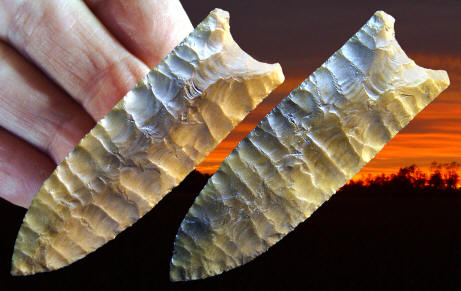|
GOSHEN
POINT
This Goshen point is one of the
more skillfully made points from the Mill Iron site. Both sides have fairly
uniform parallel pressure flaking. The fact that one side is flat may
indicate that it was made from a flake blank. The sides are parallel and the
edges were sharpened and straightened with fine retouch pressure flaking
between the flake scars. The basal concavity is uniformly curved and the
ears are squared. Basal thinning was accomplished with the removal of
several pressure flakes on both sides. This point was broken in the middle
with a bend-break type of fracture that probably happened during use, rather
than during manufacture. This point measures 2 15/16 inches (7.5 cm) long. MILL IRON SITE
The Mill iron site is
located in Carter County, Montana in the southeastern part of the state.
It's now believed that it represents the Goshen Cultural Complex as it was
described at the Hell Gap site in southeastern Wyoming. There are now five
accelerator dates on the site that average over 11,000 years before present.
It remains to be proven if Goshen is a Clovis variant or if it should be
placed somewhere between Clovis and Folsom. |
